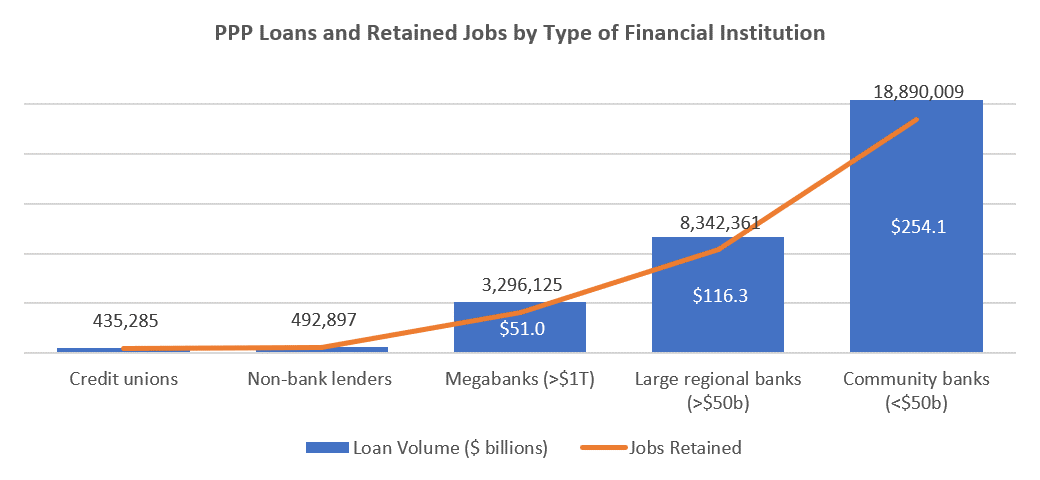|
|
You might be using an unsupported or outdated browser. To get the best possible experience please use the latest version of Chrome, Firefox, Safari, or Microsoft Edge to view this website. |
OBSERVATIONS FROM THE FINTECH SNARK TANK
The Small Business Administration (SBA) released details about Paycheck Protection Program (PPP) loans.
The data doesn’t cover all PPP loans—just those over $150,000. That still includes more than 660,000 loans valued at more than $429 billion,* about 84% of the $510 billion in PPP loans that have been issued.
The data begs three questions: 1) Who got what? 2) Where did they get it from? and 3) How well did the loans perform?
Who Got What?
Loans by Industry
Combined, manufacturing, professional services, health care, and construction companies—which comprise 36% of all businesses——took in 52% of PPP loans, each raking in more than $50 billion in loans.
Of all loans, 13% were for $1 million or more. Among the loans to Management and Education companies, however, one in five exceeded $1 million.
Loans by Ethnicity and Gender
If you’re interested in the distribution of loans by gender or race, forget about it. Of the 661,000 loan applicants, 86% didn’t specify their ethnicity and 71% didn’t state their gender.
There are, however, some surprising entries among those that did enter their ethnic background.
For example, the American College of Cardiology Foundation is listed as an American Indian-owned organization, as is Jewell County Hospital in Mankato, KS and Bob Ross Buick of Centerville, OH (which is also female-owned).
Duck Fat, a French restaurant in Portland, ME, is listed as American Indian and female-owned. When I saw the owner of the restaurant on TV a few years back (he was a finalist on the Food Channel show Chopped), he didn’t look American Indian, but I guess looks can be deceiving.
And, apparently, St. Mary Catholic Church of the Roman Catholic Diocese of Joliet (IL) is Asian-owned.
Where Did They Get It From?
The 33 largest banks—those with more than $50 billion in assets—provided $167.3 billion of PPP funds, just short of 40% of the total pie. More than 3,600 community banks contributed roughly $250 billion, with non-bank lenders chipping in $6.3 billion and credit unions adding in another $5.1 billion.

PPP Loans and Retained Jobs by FI Type
SOURCE: SBA
JPMorgan Chase was the largest bank lender with $24.4 billion in loans, Ready Capital the largest non-bank lender with nearly $1.9 billion in loans, and Mountain America FCU the largest credit union lender with almost $200 million in loans.
Overall, 16% of large regional banks’ (assets between $50 billion and $1 trillion) loans were in excess of $1 million, in contrast to 12% of community banks’, 8% of non-bank lenders’, 11% of megabanks’, and 6% of credit unions’ loans.
Toyota Federal Savings, which issued $521 million in PPP loans, had the highest percentage of large loans with nearly half (46%) of its loans exceeding $1 million.
How Did The Loans Perform?
To determine how well the loans performed, I calculated two metrics: 1) Jobs Retained per $1 Million, and 2) Loan $ Per Retained Job (they’re two sides of the same coin—one measured in number of jobs, the other in dollars).
Loan Performance by Industry
From an industry perspective, loans to hotel/food services companies were the highest performers, retaining 121 jobs per $1 million of loans and requiring just $8,273 to retain one job.

PPP Loans and Retained Job by Industry
SOURCE: SBA, CORNERSTONE ADVISORS
At the other end of the spectrum, loans to companies in the utilities, mining, professional services, and finance and insurance industries were the lowest performers, retaining just 51 jobs per $1 million in loans and requiring more than $19,000 to retain each job.
